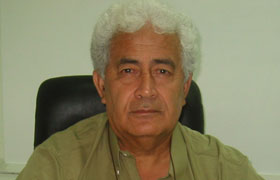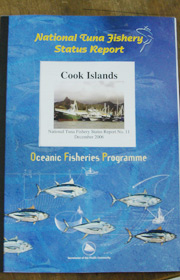Spanish fleet
threatens
our fishing

Tapi Taio
The presence of a fleet of 20 large fishing vessels operating in international waters off to the west of the Cook Islands is impacting adversely on our Swordfish and Mai Mai catch. Tapi Taio, President of the Cook Islands Tuna Fishing Association, expressed this concern to the Cook Islands Times on Thursday.
Taio said when the official data is released by the Ministry of Marine Resources on catch by species we can expect to see a drop in the Swordfish catch. Taio said the fleet vessels were Spanish, operating out of Tahiti.
Taio said the size of the Spanish swordfish catch even has Tahitian fishermen concerned. He has learnt some Tahitians are tempted to join the Spanish in fishing international waters just off the Cook Islands 200-mile extended economic zone (EEZ).
Taio said large Spanish purse seine (netting) vessels registered in Kiribati are working in the north-west international waters just outside the Cook Islands EEZ. He believes these vessels are netting everything - large and small - on the migratory path south.
He adds other Spanish purse seine vessels fishing in international waters just north of the equator, are scooping up fish on the migratory path north. Eventually, said Taio, if no controls are put in place, the fish may disappear in a few years.
QUOTAS
Taio will be proposing to the association that an approach be made to the Regional Tuna Commission recommending quotas to prevent over fishing.
Another concern, said Taio, is that those boats registered in Kiribati bring something like US$48 million a year in fees to the Kiribati government. Fishing is Kiribati’s main source of income and Taio said their Minister for Fishing told him they desperately need this revenue for alternative living space come the day their islands disappears under the rising sea level.
Taio said our government needed to review the fee structure for fishing in the Cook Islands. He feels we should be collecting more than just registration and licensing fees. According to the 2006/2007 Budget Estimates, statutory fees were estimated to bring in $540,000. (Registrations $45,000, Fishing licences: $95,000, USA Fisheries Treaty: $400,000).
Alternatives should be explored, said Taio. For example, imposing a percentage fee on the value of the fish caught in northern waters, sold to the Pago Pago canneries. Taio said the amount collected from such a fee could go to development in the Northern Group.
Export earnings from fish sales in 2005 were estimated at around $9.9 million. Of this, probably about $5 million was earned from sales to canneries in Pago Pago.
In 2004, an estimated $13.1 million of which $6.8 million was estimated to have been earned from sales to canneries in Pago. However, government’s projected earnings for the industry from 2006 onwards are expected to be lower at around $4.3 million.
ROBUST
A spokesperson for the Ministry of Marine told the Times on Friday that the issue regarding the Spanish fleet was raised and robustly discussed with European Union (EU) representatives at the last meeting of the Tuna Commission. This was in Samoa in December 2006.
With New Zealand supporting the Cook Islands, the EU agreed to hold fleet numbers to 2005 levels, much to the disappointment of the Spanish. Although quotas were not discussed, holding fleet numbers should prevent over fishing. The next meeting of the Commission will be in Pohnpei, Federated States of Micronesia, in December 2007.
The spokesperson agrees our Sword fish catch should show a decline when official figures are released.
As regards maximizing returns on the catch sold to canneries in Pago Pago, the spokesperson said other avenues had been raised and discussed in the past. The main issues of contention being; developing a manageable framework, ensuring compliance, obtaining co-operation and ensuring accuracy of data.
With the majority of the northern catch being low value Albacore, any return would not be high. A better bet might be to increase the license fee for foreign vessels.
Even if a workable system could be developed that returned a higher dividend for government, the issue of how to disperse the funds equitably and without political influence, to the various northern islands will need to be clarified.
Report a great asset

The “National Tuna Fishery Status report No 11” for 2006 has just been released.
This comprehensive and detailed report on the Cook Islands Oceanic Fisheries Programme, was produced through the Secretariat of the Pacific Community (SPC). There was input from experts from our Ministry for Marine Resources.
The report contains a summary of;
- the development of our fishing industry,
- the relationships between catch rates and ocean conditions,
- stock assessments, (Albacore, Yellow Fin, Big Eye, Other species)
- management issues.
The report contains informative historical data from as far back as 1953 when the longline fleets from Japan, Korea and Taiwan fished in our waters.
A valuable resource for our local fishing industry and the public, the document is available for viewing at the National Library.

Headlines : Times 193 26 Mar 2007
- Spanish fleet threatens our fishing
- Red Cross meeting will feature HIV, AIDS, STIs
- Area’s not for huts: Minister
- Achievement gets official recognition
- GOOD SIGNS: Road markings show Police Review action
- Training squad chosen for Oceania
- Tony Iro gets coaching job.
- Watch research, warns Sir Tom
- Lagoon Petero’s training ground
Headlines : Times 192 19 Mar 2007
- Government business units fail to meet targets
- Marurai names research boss
- Time to focus budget on real issues
- Bridge on the ball
- Letters: Waiting for Makea family to embrace truth
- Tuesday will be trial for Oceania
- Dengue mosquitoes facing new Tom Wichman threat
- Six super ministries possible
- Glitz and Glamour coming to Aitutaki